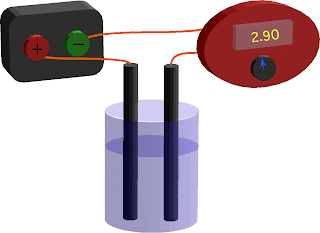Polar substances have an unequal charge distribution (asymmetrical)
H2O = polar:
LIKE DISSOLVES LIKE!
Polar solutes dissolve in polar substances and non-polar solutes dissolved in non-polar substances
___________________________________________________________
INTERMOLECULAR BONDS
- bonds between molecules
- 3 types
1.)
- Results from temporary electron dipoles
- Weakest intermolecular force
- Increases as the $ e- increases
- Occurs in any compound that has e- (ie: everything)
2.) Dipole Dipole
- Results from a permanent dipole in molecules
Polar molecules experience this force
Polarity depends how much elements want e- (electronegativity)
- Electronegativity increases to the right and up
- The strength of a dipole- dipole bond depends on the difference in electronegativity between the two atoms
- Only polar molecules experience this

Substance Boiling Point # of e-
N2 -196 degrees C 14
O2 -183 degrees C 16
NO - 152 degrees C 15
ICl 97 degrees C 70
Br2 59 degrees C 70
More electrons = higher the boiling point
3.) Hydrogen Bonds (H-Bonds)
-This is a special type of dipole- dipole bond between H and O, F, or N
- Any molecule that: H-F, H-O or H-N
Identify the substances with H-Bonds:
1) CH4
2) CH3OH
3) H2S
4) CH3-NH2
5) HCl
6) CH2-OH-OH2
/ / /
OH OH OH
Answer: Number 2, 4, and 6
Compare the boiling points of:
- Ethanol (C2H5OH)
- Ehtane (C2H6)
- Methanol (CH3OH)
- Methane (CH4)
> London Forces are the weakest intermolecular force and hydrogen bonds are the strongest.
> More electrons, the higher the boiling point.
___________________________________________________________
IONS IN SOLUTIONS
- The formation of a solution depends on the ability of the solute to dissolve in the solvent
- Solvation is the interaction between solutes and solvents
- Ionic solids (salts) are cyrstals made up of ions
- Molecular solids are crystals made up of neutral molecules
- Dissolving ionic solutions produces ions in a process called disssociation (remember?)
Ionizaiton is the break up of a neutral molecule into charged particles
Examples:
1) FeCl3 (s) ----->Fe 3+ (aq) + 3 Cl -1 (aq)
2) Ag2O (s) -----> 2 Ag + (aq) = O 2- (aq)
Determining concentrations is relatively easy.
Cl = 3x as many moles = (0.5 M) x 3 = 1.5 M
What is the [NO3-] in a solution of 0.82 M Fe(NO3)2?
Fe(NO3)2 -----> Fe 2+ (aq) + 2 NO 3- (aq)
(0.82 M) x 2 = 1.64 M
What is the [Cr2O7 2-] and [K+] when 3.5 g of K2Cr2O7 dissolved in 40 mL of water?
K2CrO7 -----> CrO7 2- (aq) + 2K + (aq)
3.5 g x 1 mol/294.2 g = 0.0














